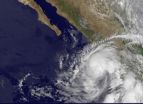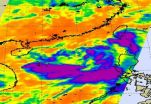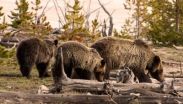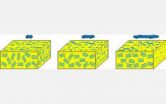The study found that, overall, composition of a plant community is a weak predictor of the composition of a bee community, which may seem counterintuitive at first, said USGS scientist and study lead Ralph Grundel. This may be because specialized plant-bee interactions, in which a given bee species only pollinates one plant species and that plant species is only pollinated by that bee species are not common. More common is for a plant species to be pollinated by many pollinator species and each pollinator species pollinating many species of plants.
Given this complex network of interaction between plants and their pollinators, it is not surprising that knowing which plants occur in an area does not necessarily allow us to predict which bees will occur in that area, Grundel said.
Unraveling such mysteries surrounding how native bees inhabit and use different habitats is especially essential now -- the National Academy of Sciences has reported that not only is there direct evidence for decline of some pollinator species in North America, but also very little is known about the status and health of most of the world's wild pollinators. Yet without them, the ability of agricultural crops and wild plants to produce food products and seeds is jeopardized.
"The issues facing honeybees, introduced pollinators whose populations are spiraling downward, means that it is even more vital to understand the role of native bees as pollinators and how they divide up and use a landscape," said Grundel.
Many studies have been conducted to determine how a variety of animals – birds, mammals, and reptiles, for example – use their native landscapes, but few such studies have been undertaken for native bees. "That's why this type of study is fundamental for enhancing our understanding of native bee distribution," Grundel said. "Our research findings clearly reveal that maintenance of a diverse and abundant bee community requires that managers consider a suite of local and landscape characteristics and management actions."
Grundel and his colleagues wanted to find out if the kinds of plants that live in different habitats can predict what kinds of bees will be there or if other factors – such as soil type, tree density or even fire -- are more important. To do this, the team surveyed landscapes and collected and identified nearly 5,000 native bees representing at least 175 species in five kinds of habitats at Indiana Dunes National Lakeshore and nearby natural areas around northwestern Indiana. These habitats ranged from dense forests to open fields.
"We had suspected that the closer our collecting sites were to each other the more similar the bees communities we found would be – but we were wrong," Grundel said. "In fact, mere physical proximity wasn't a very good predictor of how similar bee communities at different sites would be to each other. Instead, local factors – and even the micro-habitats that we often ignore – are really important in determining what kinds of bees use an area."
Because many native bees are ground- and cavity-nesters, the scientists weren't surprised to find that an abundant supply of dead wood, such as woody debris and dead tree limbs, was essential in determining what kinds of bees lived where. They were surprised, however, at how important other factors were, including bee preferences for specific soil characteristics and for areas that had burned in the previous two years.
Bee abundance – how many bees were captured at a site – was lower in areas with a dense tree canopy and higher if a fire had occurred recently in the area. Bee diversity – the number of different kinds of bees – was higher in areas with less tree canopy, but with a higher diversity of flowering plants and an abundance of nesting resources, such as woody debris.
The presence of suitable nesting material was at least as important in determining how many types of bees might use a site as was diversity of plants, which provide nectar and pollen to the bees. The composition of an entire bee community was linked to higher plant variety, less canopy cover and soil characteristics that may be best-suited for nesting.
The study found that specialist bees – those picky native bees that gather pollen from only a few kinds of plants – were more likely to live in open areas than areas with a higher density of trees.
"Specialist bees, not surprisingly, were also more associated with the presence of native plants in the areas, but a lot of these native plants were more likely to occur in disturbed areas, including areas that had recently been burned and, somewhat to our surprise, residential areas where soil disturbance is commonplace," Grundel said.
However, specialist bees were often rarer and mainly used open habitats, such as grasslands and savannas. According to a 2005 study, said Grundel, such open Midwest habitats are today perhaps the most poorly conserved habitats on the planet, causing concern about long-term conservation of such bee species.
"At several locations around the world, specialist bumblebees living in plant rich areas, such as these open habitats, have declined significantly," Grundel said. "Similar bumblebee declines have been documented in the Midwest U.S. Documenting how diet breadth, rarity and habitat use are related is important for understanding such patterns of decline and was one of the main objectives of our study. We collected six bumblebee species in our study while a 1930s study in this area collected twelve species. Four of the species we did not find in our study have been identified as bumblebees of special concern due to their disappearance from sites across the Midwest."
USGS researchers in Indiana and Maryland are following up on this research with a recently initiated study examining how native bee populations across the national park system might be affected by climatic variation.
###
The paper, Floral and nesting resources, habitat structure, and fire influence bee distribution across an open-forest gradient, was published in Ecological Applications and may be read at http://www.glsc.usgs.gov/_files/publications/1564.pdf. Primary authors are Ralph Grundel, USGS; Robert Jean, Indiana State University; and Krystalynn Frohnapple and Noel Pavlovic, USGS.
USGS provides science for a changing world. Visit USGS.gov, and follow us on Twitter @USGS and our other social media channels.
Subscribe to our news releases via e-mail, RSS or Twitter.
END






